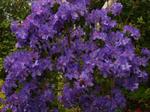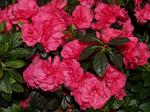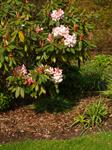
There are lots of different types of rhododendrons. Some are tall trees, others low spreading shrubs. Many are indigenous to cold mountains, such as the Himalayas, but others occur naturally in hot. humid, tropical rainforests.
Rhododendrons include some of the most popular garden plants we grow. Azaleas are a type of Rhododendron, Mollis Rhodos are deciduous and Virayas are tropical.
Read on and find out more about growing them.
Soil Needs
They do best in well-drained, aerated and slightly acidic soil (pH of 5 to 6) with high organic matter content. By contrast, they will not survive in very chalky or limey soils which are alkaline. A sandy loam is ideal but other soils can be modified to suit their needs better. For instance, heavy clay soils can have organic matter such as well-rotten manure or leaf mould worked into them to lighten them, and the same can be added to light soils to make them richer. If you have less than ideal soil and have to modify it, it is essential that the modified soil drains well because their roots will rot otherwise. That said, the roots should not be allowed to dry out completely.
Light Requirements
Rhododendrons need protection from strong direct sunlight and from cold winds. Generally, a cool and humid atmosphere is preferred. It is said that those species which have smaller leaves can tolerate more sun than broader leaf types, but none of them should be positioned where they are in full sun all day long in warmer climates. It is beneficial to apply a layer of organic mulch to prevent wide fluctuations in temperature at the root zone.
Cultural Needs

Plants may be fertilised in spring to promote buds and flowering. However, because they are relatively shallow rooted plants it is easy to over-fertilise. If the soil is already rich then it may not be necessary to fertilise. Fertiliser should not be applied in late summer otherwise you may encourage new tender growth which can be damaged by cold winter weather. Fertiliser formulations for acid loving plants are best, and those which include nitrogen in the ammonium form are preferable.
It is widely recommended to only fertilise once in spring each year, or at most once in spring and once when flowering. If you use a general purpose fertiliser, it should have an NPK ratio in the region of 6: 10: 6, or 4: 6: 4. Use it at half the recommended strength, not full strength. Do not feed newly planted specimens. They need time to settle before they can be fertilised or you risk damaging the roots.
Rhododendrons benefit from deadheading. This is usually best done by pinching the dead flowers heads between the thumb and forefinger because secateurs can cause damage to young shoots. Deadheading has two advantages – it makes plants look tidier, and more importantly removal of the dead tissue promotes flowering from the same stem the following season. When deadheading, be sure to take the seed pods with the old flower head because they drain significant energy from the plant.
Other than deadheading, rhododendrons and azaleas do not need any regular pruning although specimens can be pruned back to maintain shape, encourage bushy growth, or to remove straggly stems. This should be done in spring. Plants which have become untidy can be cut back hard to 30cm. Grafted species should not be hard pruned.
 For More about Rhododendrons
For More about Rhododendrons
1. Study our 100 hour Rhododendron and Azalea Home Study Course -
click for details
2. See our bookshop for Books written by our principal, John Mason, and horticultural staff
-click for details